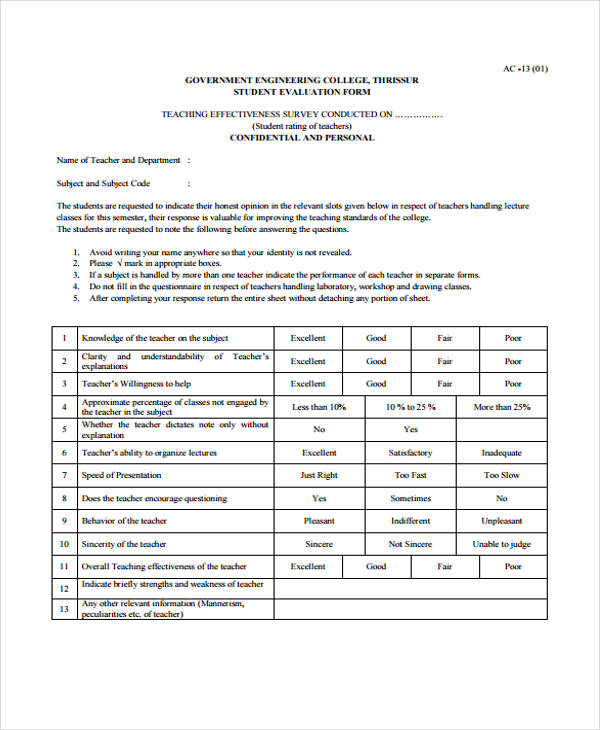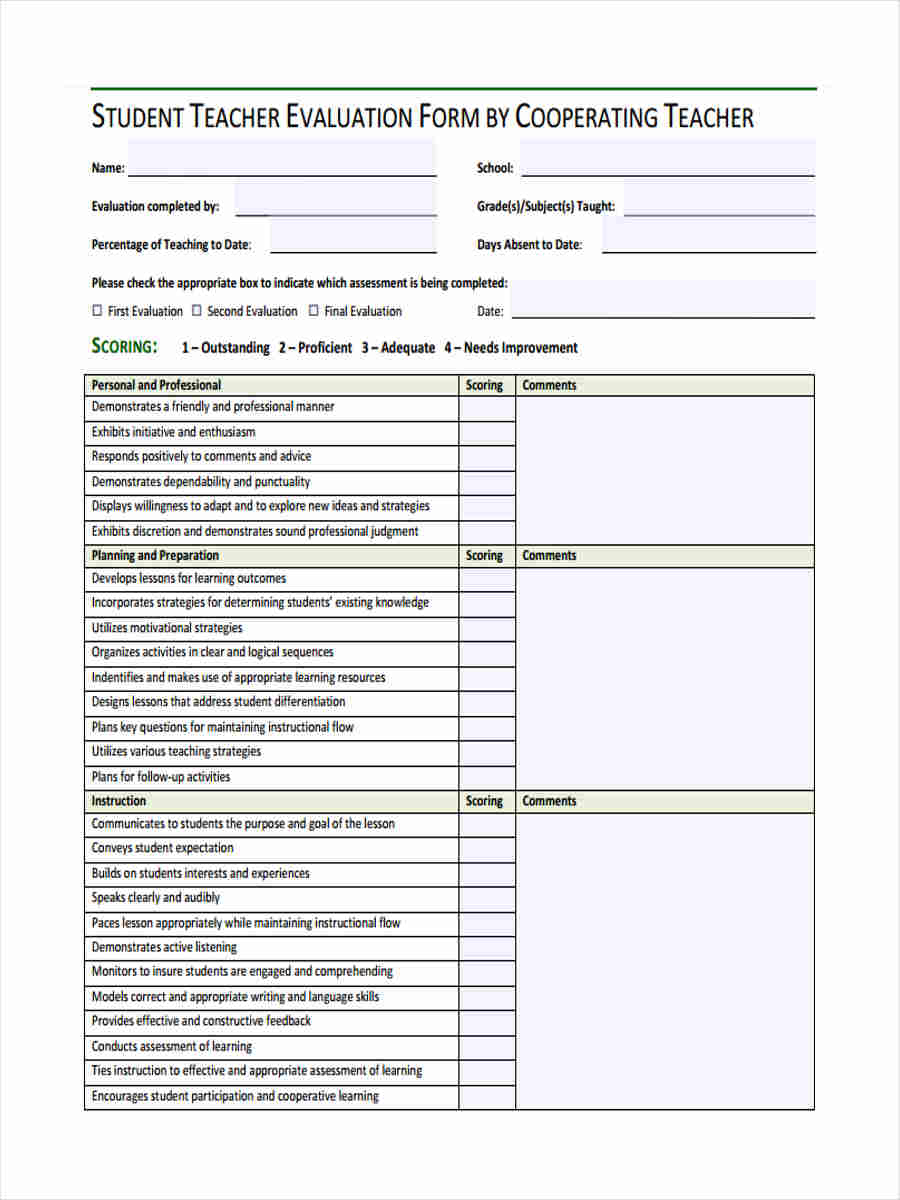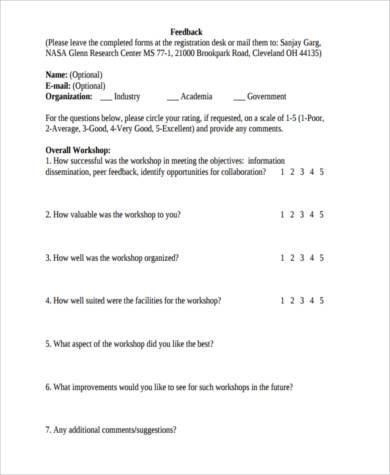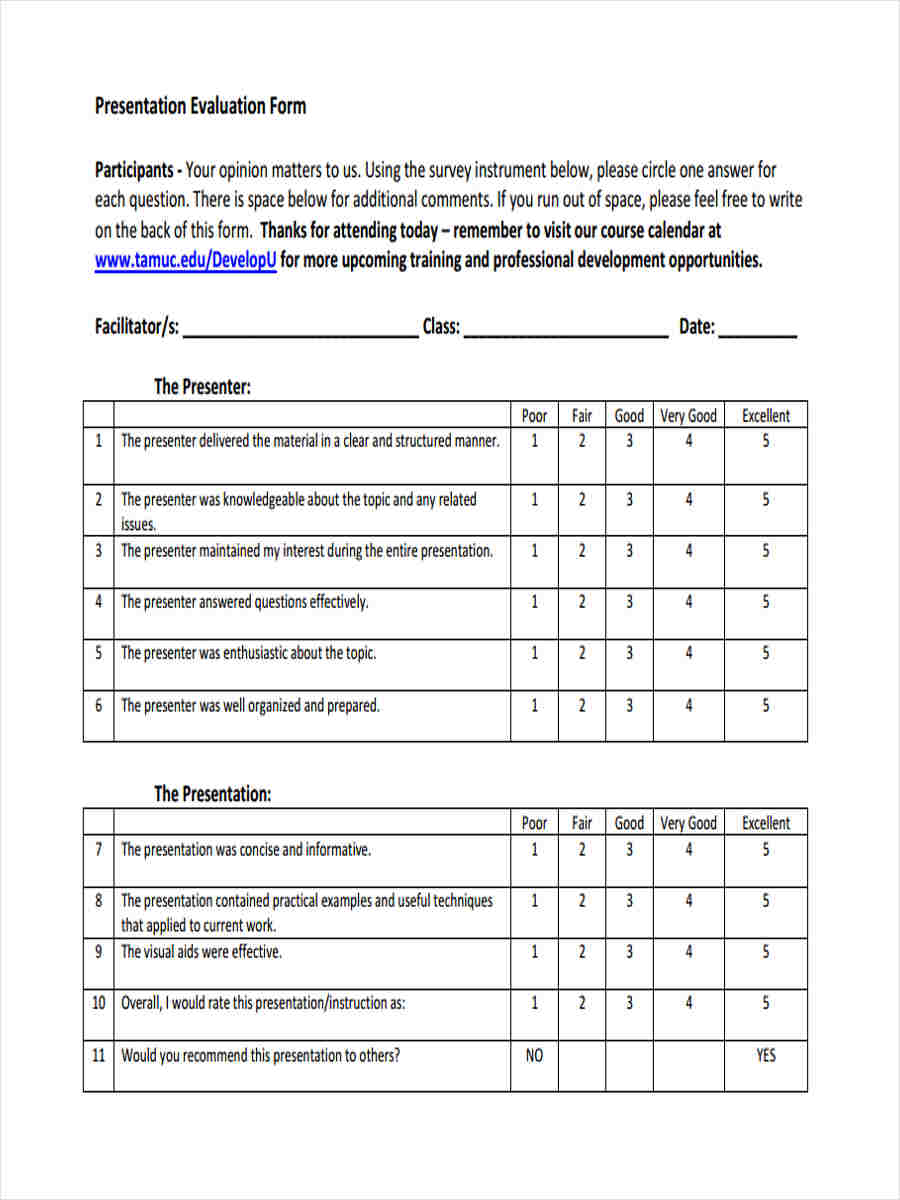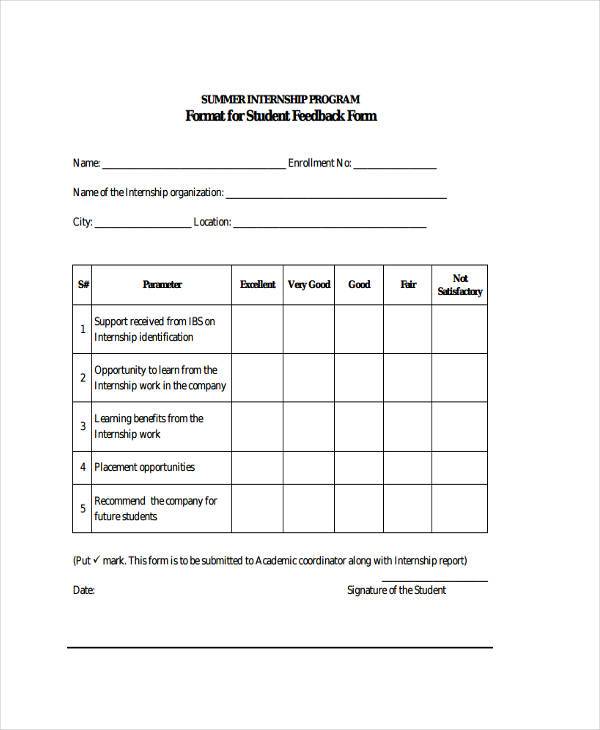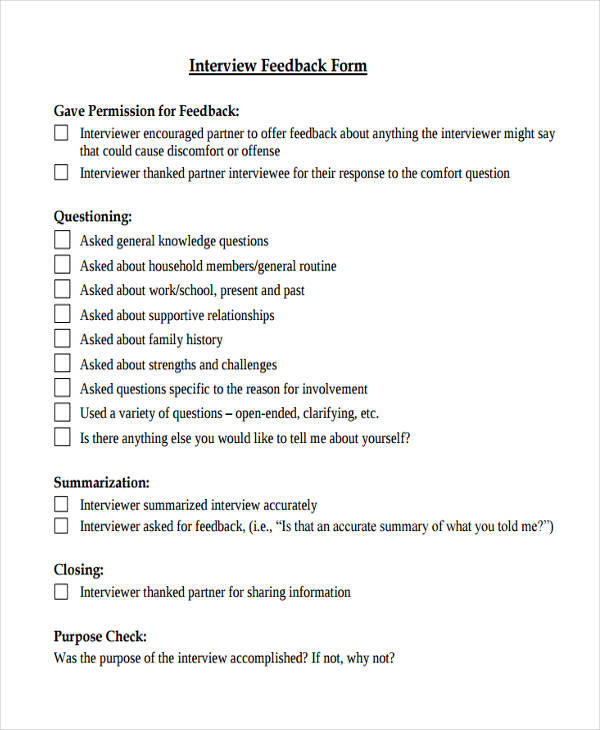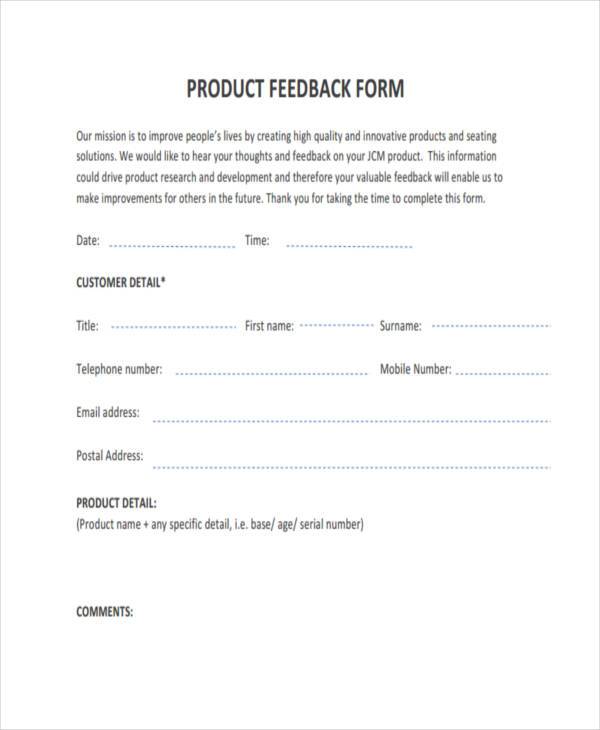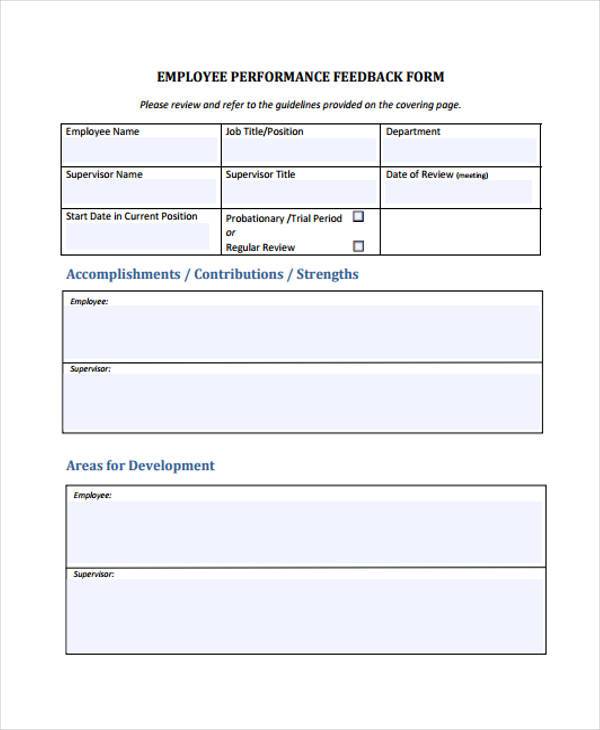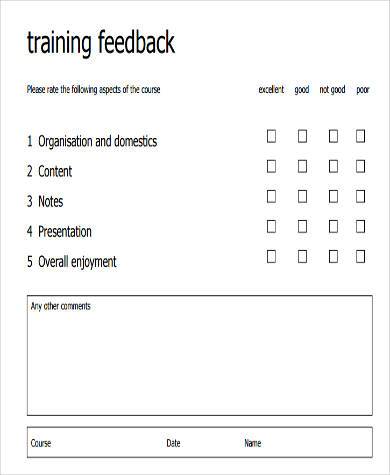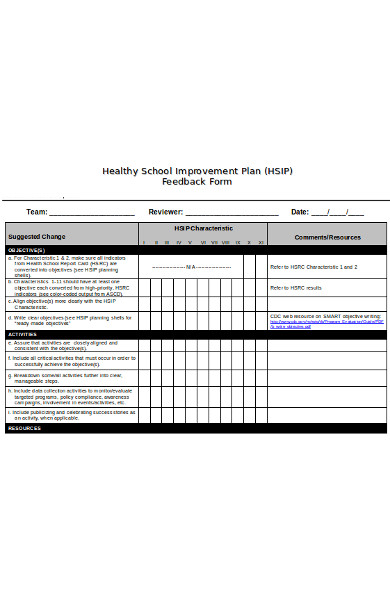Feedback is being given on a daily basis. It can be given at any point in time and one can hand out either positive or negative feedback. The reason as to why one must provide feedback is because it will help the receiver grow and possibly achieve success.
So it’s very important that one learns how to hand out efficient feedback by knowing what information to present and how to present it to the receiver. Because of misinterpreted the wrong way, feedback could possible destroy someone’s motivation and development rather than help. So always be careful and learn how to provide quality feedback.
Student Feedback Forms
Teacher Feedback Form
Workshop Feedback Form
How to Write a Feedback Form
For those that would like to write-up their own feedback form, then be sure to provide the following information:
- Name of the person/receiving receiving the feedback
- Name of the person/receiving handing out the feedback
- Date of when the feedback is being provided
- A proper rating system
- Instructions on how to utilize the rating system
- Qualities and aspects that are being rated
- A comment or suggestion section
If you would like to know more on how to write other types of feedback forms, then you may go through our sample feedback forms to help you.
The Importance of Feedback Forms
One of the reasons why one must make use of feedback forms is because there is so much information that one can gain. Considering that there are different methods, one can use any of them to get what others think about their products, services, events and more. For example, a business makes use of customer service survey forms and designs a set of questions that asks about the level of satisfaction that they gain from using their products. When they receive the results of these forms, then businesses are able to adjust to what their customers want and fix any problems they have. Feedback is a continuous tool of learning wherein one can make important decisions or devise strategies that can help guarantee success.
Presentation Feedback Form
Internship Feedback Form
Interview Feedback Form
The Different Types of Feedback Forms
Considering that there are different type of feedback forms, one must learn how to properly utilize each and every single one of them. Or at the very least, learn about them should the situation call to use any of them. So here are a few examples of these types of forms as well as their purposes.
- Student Feedback Forms. These are the kind of forms that students utilize for when they are required to assess any of their teachers. What student feedback forms do is allow the students to point out what they like or dislike about a particular teacher, subject, or even facility. These forms can also be used by the teachers to provide feedback on the students to see whether or not they are performing well in terms of academics, or how well they are behaving within the premises of the school.
- Camp Feedback Forms. These forms are made use by any person who have taken part in any camping programs. What these forms is to allow these people to rate their experience of their camping session. Also, this type of form allows the participants to make further suggestions on what the camping program can improve on so that future participants are able to have a much better experience. So make use of camp feedback forms to ensure that future camping experiences are better for you and others.
- Event Feedback Forms. These forms are what event organizers need to hand out to every participant of their event. With the help of event feedback forms, every event organizer is able to gain vital information that will tell them about the success or the failure of their event. So what these forms look into are the different factors that affect either failure or success such as the vendors, programs, speakers, location and much more.
- Interview Feedback Forms. This are the forms that just about every employer must make use of in the event that they acquire candidates for employment. With interview feedback forms, those in charge of handling interviewees are able to utilize these forms to assess how well they performed during the interview. So these assess things such as the person’s communication ability, knowledge about the position, qualification and much more. There are also instances wherein one can use these forms to rate the interviewer. The results would show if the interviewer was competent enough in handling the interview, or if someone else would have been better in handling it.
- Performance Feedback Forms. With these forms, one is able to able to show the level of performance of others. For those that have to make use of performance feedback forms, they would have to gather all evidence of the work done by the person being assessed. Then the information must then be properly looked into to see if that person was able to achieve a certain goal. For someone receiving the results of these forms, that person would be able to determine what is holding him or her back from achieving a certain goal, or to show how that person was able to accomplish everything that needed to be accomplished.
- Employee Feedback Forms. These are what are used by just about every company and organization for when the have to provide feedback to their employees. Employee feedback forms are used to assess the performance and behavior of the employee, as well as the quality of work an employee has been able to produce. This can help businesses determine whether an employee should be praised for all the effort made to achieve certain business goals, require training for further improvement, or dismissed due to very underwhelming performance.
Product Feedback Form
Performance Feedback Form
Event Feedback Form
Training Feedback Form
Formal Quality Feedback Form
Ten Ways to Provide Quality Feedback
- Point out the positives. If the person you are giving feedback has been doing well, or has done anything good that should be taken note off, then you will want to point that out. It will increase that person’s motivation to produce more work and do even better.
- Be specific as to what you are pointing out. Whether it is positive or negative feedback, you are going to want to properly explain what it is the receiver of the feedback did right or wrong. So provide important details and possibly even provide evidence that back up your claims.
- Make it a two-way conversation. You should allow the employee to provide information rather than just you talking. Let the employee have a say during the feedback because you might just something you’ve never heard of such as certain achievements the employee was able to accomplish without your knowing.
- Be timely and provide the feedback as soon as possible. Lets say that you have just appraised the performance of your employee and see that there are a couple of problems that need to be addressed. Do not wait too long before you tell that employee on what he or she has done wrong, tell that employee as soon as you have the chance. The reason being is that if you take too long to tell the employee, he or she could have already forgotten the details as to the mistake/mistakes that were made. Relying on memory is too unreliable so it’s always best to give feedback while the incident is still fresh.
- Never let your emotions get out of hand. You want to make sure that you remain calm and retain a professional atmosphere when handing out feedback. You do not want to let your emotions get the better of you as it could lead to serious repercussions. So no matter how much the receiver of the feedback is infuriating you, do your best to keep your emotions in check and focus on the matter at hand.
- Remember that the aim of providing feedback is to move a person forward. You don’t want to put a person down, you want to make sure that the receiver is getting information that states that he or she should improve. So ask that person on what can be done to improve results in the future and provide that person with advice or suggestions to ensure that success is attained.
- Point out the specific goals that have to be achieved. Sometimes a person forgets as to why his or her effort is important. So lets say you are reviewing an employee and it shows that he or she isn’t meeting the target sale for the month. So what you should do is remind the employee of what the goal is and helping that employee achieve it.
- Do a follow up. After your initial feedback, you are going to want to keep track of that person’s progress. Not only will this tell you if that person took your advice and solutions, but it also lets that person know that you are monitoring him or her with a close eye. After a while, you must then provide feedback again after assessing the results and tell that person if he or she is improving, or if there are still areas that need to be worked on.
Related Posts
7+ Student Feedback Form Samples - Free Sample, Example ...
Sample Hotel Feedback Forms - 7+ Free Documents in Word, PDF
Sample Teaching Feedback Forms - 9+ Free Documents in Word, PDF
Sample Guest Feedback Forms - 7+ Free Documents in Word, PDF
Sample Course Feedback Forms - 8+ Free Documents in Word, PDF
Sample 360 Degree Feedback Forms - 7+ Free Documents in Word ...
Sample Lesson Feedback Forms - 8+ Free Documents in Word, PDF
8+ Sample Peer Feedback Forms - Example, Sample Format
16+ Teacher Feedback Forms in PDF
Sample Faculty Feedback Forms - 8+ Free Documents in Word, PDF
21+ Sample Presentation Feedback Forms
7+ Training Feedback Form Samples - Free Sample, Example ...
Sample Feedback Forms in PDF - 40+ Free Documents in PDF
Sample Air Force Feedback Forms - 8+ Free Documents in Word, PDF
10+ Sample Workshop Feedback Form Sample Forms

